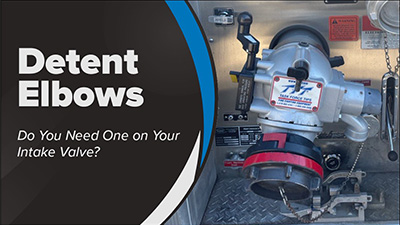Is a Detent Elbow Right for Your Intake Valve?
If you are evaluating intake valves you are going to need to decide on the type of elbow you want. One possibility is a detent elbow.
You may be wondering what a detent elbow is and what the potential benefits are.
In this article we will go over what a detent elbow is, how it works, and why you might or might not want this option.
Are you debating which style of elbow you need on your intake valve? Read our article on straight vs bent elbows here!
What is a Detent Elbow?
A detent elbow is a type of elbow for your intake valve. The elbow is pitched at about 30 degrees and can swivel. The detents are various positions where you can stop and lock the elbow into place. This ability to swivel and lock the elbow into a new position means you can change the angle your elbow uses to connect to your large diameter hose line.

How Does a Detent Elbow Work?
A detent elbow is extremely easy to work. You simply unlock the elbow, swivel to a new position, and lock it into its new position. There are no complicated mechanisms to operate, and if you leave the elbow unlocked, it will swivel with the LDH as it is being charged. This allows the LDH to get the twists out and naturally moves the detent elbow into the best position to achieve full flow to your pump.
Three Reasons You Might Want a Detent Elbow
There are a few reasons you might want a detent elbow for your fire apparatus.
Pump Panel Layout
Some pump panel layouts make it difficult to choose an intake valve. If your pump panel sits behind a roll up door, a potential solution is the detent elbow. These allow you to swivel and lock the elbow into a specific position when it is not in use. This position often takes up less space than an elbow that cannot move, giving you more options without sacrificing utility.
The detent elbow may be helpful if you still want some flexibility but have a less than ideal pump panel setup. With the swivel you can still access many of the detent positions without compromising your waterway.
Easier LDH Connections
We all know that connecting large diameter hose to your intake valve can be difficult if the angle isn’t ideal. With a detent elbow you can change the angle and make your connection easier! This means you can swivel and lock your detent elbow to better align with your water source whether that is a hydrant or draft.
Keep Roadways Clear
Another benefit to the detent elbow comes with the ability to swivel and lock into a new position. On some fire grounds, the water source and apparatus location make it difficult to connect without blocking the roadway. Blocked roadways make it more complicated for your second due apparatus when it pulls up. With a detent elbow, you can adjust your angle and connect in a way that allows you to keep the roadway clear, making an easy path for your second due.
When is a Detent Elbow not Right for You?
The detent elbow is a useful option for your intake valve, but it may not be right for you.
Limited Pump Panel Space
Some pump panels cannot accommodate an elbow on the intake valve, even with the detent elbow. In this case, you may need a straight intake to avoid obstructions or interference with a roll up door.
Low Intake Position
If your intake valve is very low to the ground, a detent elbow may not be right for you. A straight intake may be more ideal for your crew. Any style of elbow may cause issues by driving your hose line directly into the ground, causing kinks and restricting water flow.
Conclusion
A detent elbow can be a valuable tool when you want flexibility for your intake valve. While it is not right for every apparatus or crew, for many it can assist with LDH connections, help keep roadways clear, and solve space issues on the pump panel.
